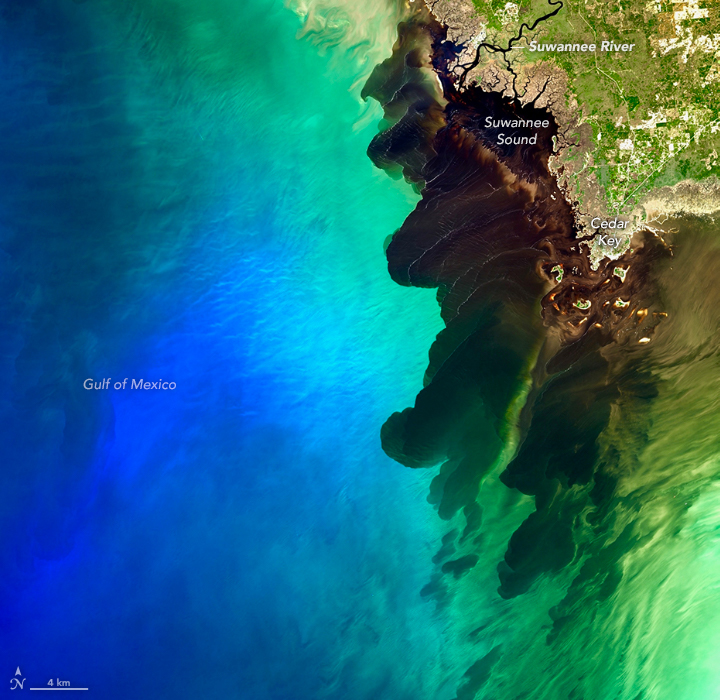Post by syzygy on Oct 31, 2018 7:46:51 GMT
all this a short quotation from a recent nasa-EO article on archive satellite imagery and (not best aligned) overlay of the image.
read full article from source: earthobservatory.nasa.gov/images/144147/a-blackwater-river-meets-the-sea
***
blackwater overlay.kmz (708 B)
A Blackwater River Meets the Sea
NASA Earth Observatory image by Dr. Alice Alonso, using Landsat data from the U.S. Geological Survey. Story by Laura Rocchio, NASA Landsat Science Outreach.

February 20, 2015
In a dense swampland in Georgia, just north of the Florida border, you find the headwaters of the Suwannee River. The Suwannee is known as a “blackwater river” because of its dark-brown waters laden with organic material. This river system has been called one of the most pristine in the United States, but some environmental pressures are putting that distinction in jeopardy.
Unlike other blackwater rivers, the Suwannee maintains its inky color along its entire 400-kilometer (250-mile) journey to the sea. When the river finally meets the Gulf of Mexico along Florida’s Big Bend—that portion of coast where the state’s panhandle curves to meet its peninsula—its dark waters act like a tracer, revealing whereby the river water mixes with the sea. That mixing was on display on February 20, 2015, when the Operational Land Imager on Landsat 8 captured this view. Certain colors in the visible-light image have been enhanced to bring out the details in the Gulf of Mexico.
To understand the color of the Suwannee River, you have to start at its source. In Georgia’s boggy Okefenokee Swamp, the peat deposits are so extensive that the ground quivers with every step.
It is in this swamp that the nascent Suwannee River first encounters large amounts of decaying vegetation. As these leaves, branches, and bark decay, the tannins that once protected the vegetation dissolve into a substance that dyes the river a brown so dark that it borders on black. The amount of dark dissolved organic matter, or humic substances, in the Suwannee River is nearly ten times higher than other streams around the world.
...
NASA Earth Observatory image by Dr. Alice Alonso, using Landsat data from the U.S. Geological Survey. Story by Laura Rocchio, NASA Landsat Science Outreach.

February 20, 2015
In a dense swampland in Georgia, just north of the Florida border, you find the headwaters of the Suwannee River. The Suwannee is known as a “blackwater river” because of its dark-brown waters laden with organic material. This river system has been called one of the most pristine in the United States, but some environmental pressures are putting that distinction in jeopardy.
Unlike other blackwater rivers, the Suwannee maintains its inky color along its entire 400-kilometer (250-mile) journey to the sea. When the river finally meets the Gulf of Mexico along Florida’s Big Bend—that portion of coast where the state’s panhandle curves to meet its peninsula—its dark waters act like a tracer, revealing whereby the river water mixes with the sea. That mixing was on display on February 20, 2015, when the Operational Land Imager on Landsat 8 captured this view. Certain colors in the visible-light image have been enhanced to bring out the details in the Gulf of Mexico.
To understand the color of the Suwannee River, you have to start at its source. In Georgia’s boggy Okefenokee Swamp, the peat deposits are so extensive that the ground quivers with every step.
It is in this swamp that the nascent Suwannee River first encounters large amounts of decaying vegetation. As these leaves, branches, and bark decay, the tannins that once protected the vegetation dissolve into a substance that dyes the river a brown so dark that it borders on black. The amount of dark dissolved organic matter, or humic substances, in the Suwannee River is nearly ten times higher than other streams around the world.
...
***
blackwater overlay.kmz (708 B)
